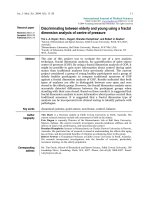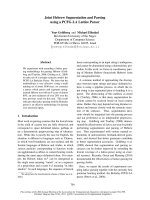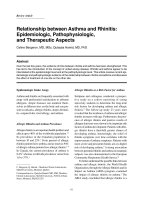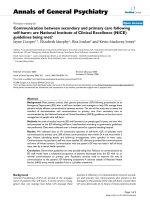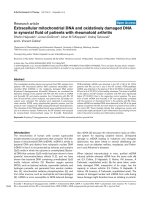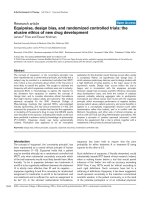Báo cáo y học: "Discriminating between elderly and young using a fractal dimension analysis of centre of pressure"
Bạn đang xem bản rút gọn của tài liệu. Xem và tải ngay bản đầy đủ của tài liệu tại đây (249.67 KB, 10 trang )
Int. J. Med. Sci. 2004 1(1): 11-20
11
International Journal of Medical Sciences
ISSN 1449-1907 www.medsci.org 2004 1(1):11-20
©2004 Ivyspring International Publisher. All rights reserved
Discriminating between elderly and young using a fractal
dimension analysis of centre of pressure
Research paper
Received: 2004.1.21
Accepted: 2004.2.05
Published:2004.3.10
Tim L. A. Doyle
1
, Eric L. Dugan
2
, Brendan Humphries
3
, and Robert U. Newton
1
1
School of Biomedical and Sports Science, Edith Cowan University, Perth, WA 6027,
Australia
2
Biomechanics Laboratory, Ball State University, Muncie, IN 47306, USA
3
Faculty of Education, Health, and Science, Charles Darwin University, Darwin, NT
0815, Australia
A
A
b
b
s
s
t
t
r
r
a
a
c
c
t
t
The aim of this project was to evaluate the use of a new analysis
technique, fractal dimension analysis, for quantification of quiet stance
centre of pressure (COP). By using a fractal dimension analysis of COP, it
might be possible to gain more information about control during quiet
stance than traditional analyses have previously allowed. The current
project considered a group of young healthy participants and a group of
elderly healthy participants to compare traditional measures of COP
against a fractal dimension analysis of COP. Results indicated that both
types of analyses are able to distinguish between eyes open and eyes
closed in the elderly group. However, the fractal dimension analysis more
accurately detected differences between the participant groups when
standing with their eyes closed. Based on these results it is suggested that
fractal dimension analysis is more informative about posture control than
traditional measures. It is suggested that a fractal dimension type of
analysis can be incorporated into clinical testing to identify patients with
pathologies.
K
K
e
e
y
y
w
w
o
o
r
r
d
d
s
s
dynamical systems, quiet stance, non-linear, control, balance
A
A
u
u
t
t
h
h
o
o
r
r
b
b
i
i
o
o
g
g
r
r
a
a
p
p
h
h
y
y
Tim Doyle is a Doctoral student at Edith Cowan University in Perth, Australia. His
current research interests include risk assessment of falls in the elderly.
Eric Dugan is currently Director of the Biomechanics Lab at Ball State University,
Muncie, Indiana. His current research investigates musculo-tendinous stiffness and its
affects on injury risk, performance, and neuromuscular control.
Brendan Humphries lectures in Biomechanics at Charles Darwin University in Darwin,
Australia. His particular line of research is aimed at understanding the effects that aging
has on bone, and the potential benefits of vibration on enhancing bone in this group.
Robert Newton is Foundation Professor at Edith Cowan University in Perth, Australia.
His research incorporates investigations into the benefits of exercise, particularly
resistance training, on the elderly population.
C
C
o
o
r
r
r
r
e
e
s
s
p
p
o
o
n
n
d
d
i
i
n
n
g
g
a
a
d
d
d
d
r
r
e
e
s
s
s
s
Mr. Tim Doyle, School of Biomedical and Sports Science, Edith Cowan University, 100
Joondalup Drive, Joondalup, Perth, WA, 6027. Phone: (Int+61)(8) 9400-5097. Email:
Int. J. Med. Sci. 2004 1(1): 11-20
12
1. Introduction
Centre of pressure (COP) traces derived from force readings have the potential to inform us about
the control strategies used for postural stability; they are easily garnered, non-invasive, and immediate.
COP traces represent the movement of a person about a stable position in both the sagittal and frontal
planes. Provided that a person’s COP remains within allowable limits, the person will remain standing
upright. Difficulty lies in deciphering the information contained within these traces and distinguishing
one from the other. However, with recent advances in the area of chaos and mathematics, in particular
non-linear techniques for analysis, fractal patterns of natural phenomena are being revealed. A fractal
pattern gives description to irregular shapes such as COP traces, and provides us with a means to
describe them in opposition to the traditional thinking that these patterns are derived from some random
mechanism. Currently there is a paradigm shift towards recognising the chaotic properties of natural
phenomena and the use of appropriate non-linear analysis, such as fractal analysis, in place of
traditional analyses [1].
A strong reason behind this paradigm shift is the acknowledgment of variability in natural systems
to be healthy and, in fact, desirable. In other natural systems such as control of heart rate, heartbeats do
not occur at regular intervals but at seemingly random intervals. Similarly, when asked to walk on a
treadmill, stride lengths and frequencies are just slightly unevenly spaced. Such variability in these
systems allows for accommodations to external perturbations, for more regular systems even the
slightest perturbation can lead to a complete breakdown of the system e.g., a fall following a trip during
gait versus a stumble to recover. Many researchers assume this variability to be a super-imposed noise
on an otherwise regular signal [2, 3]. However, this view is being opposed in the literature and rather a
variable signal is now viewed as natural [4, 5, 6].
New methods for quantifying signal variability are needed in order to determine the affects of such
variability. Higuchi [7] has provided a relatively straight-forward technique that can be applied to time-
series data to extract the fractal dimension. When applied to data such as COP displacement, a fractal
dimension will be reported that lies between 1 and 2. Data with no variability, for example the unlikely
situation where a person is standing completely stationary with no postural sway, will have a fractal
dimension of 1. Typical COP data that has been filtered using standard methods e.g., Butterworth low
pass filters, will also have a fractal dimension tending towards 1. In this case, the natural variability of a
signal has been removed and as a result the complexity of the signal has been lost due to inappropriate
treatment of the data. What remains are the gross movements associated with quiet stance COP, but the
subtleties have been lost. For data that has been randomly generated or data with too high a noise
component the fractal dimension will tend towards 2, indicating that the signal is indiscriminately
wavering about its underlying signal.
Peng, Hausdorff, and Goldberger [8] have demonstrated that normal human gait has a robust
fractal pattern. This fractal pattern is disturbed when one is asked to walk in time to an outside timing
mechanism instead of one’s own ‘internal clock’. Yamada [4] used a type of non-linear analysis that is
analogous to the fractal dimension, the Lyapunov exponent, and determined COP data to be chaotic
while five participants both a) stood still, and b) swung their arms while standing still. Earlier, Collins
and De Luca [9] had determined COP trajectories to be stochastic, modelling these trajectories as
random (non-deterministic) motion. The research of Yamada [4] opposed this view and successfully
demonstrated that COP trajectories are in fact chaotic (deterministic). Blaszczyk and Klonowski [10]
performed a non-linear analysis of 12 healthy elderly participants’ COP data and found that a fractal
dimension analysis, using Higuchi’s algorithm revealed a difference between participants when they
stood a) with their eyes open, and b) with their eyes closed. COP patterns were determined to have a
higher fractal dimension when eyes were closed compared to standing with eyes open. It is important to
note, that in this study, a loss of visual information while standing is accompanied by a significant
increase in the fractal dimension of the COP. This implies that an increase in the fractal dimension of
the COP during quiet stance may be an indicator of postural instability or the use of less stable control
strategies. Most recently, Harbourne and Stergiou [11] investigated COP of infants in three different
stages of sitting postural development. Using non-linear analysis techniques including: the Lyapunov
exponent, correlation dimension, and approximate entropy, these researchers showed that the
development of an infant’s sitting postural control is not only a dynamic process but one that agrees
with Bernstein’s [12] proposition that the development of natural systems involves controlling the
Int. J. Med. Sci. 2004 1(1): 11-20
13
degrees of freedom inherent in the system. In the case of infants developing their control of sitting
posture, the first stage of development was characterised by constraining the degrees of freedom to
control the system, and subsequent releasing of these degrees of freedom allowing for greater
adaptability to their environment. These findings from Harbourne and Stergiou [11] provide further
evidence opposing Collins and DeLuca’s [9] suggestion that natural systems, such as those responsible
for postural control are the consequence of stochastic processes. If we accept that variability in natural
systems, such as COP control, is normal then a deviation away from a fractal pattern may be indicative
of a shift towards an unhealthy or less desirable control strategy. The analysis of fractal patterns in gait
and posture data may serve as an indicator of pathology or impairment. Surrogate data analysis is used
to test for a system’s non-linearity. This check for non-linearity via the use of surrogate data analysis
has been used widely in the past and most recently to assess the variability of gait data in the elderly [6].
Together with the above research that has identified non-linearity in natural systems, surrogate data
analysis provides a means by which to determine if non-linear analysis techniques are warranted, if not
necessary. This surrogation process involves reconstructing new data sets from these original data;
results from both data sets are compared to each other. If the results are significantly different from
each other, then non-linear analysis of the original data can be considered appropriate.
Recently Parkinsonian patients (PP), spinocerebellar ataxia (SCA) patients, and healthy
participants’ COP were analysed using a more traditional fractal dimension analysis [13]. This method
recorded COP data and analysed COP traces using an image analyser to calculate the fractal dimension
directly from the image, as opposed to a time series data analysis such as in Higuchi’s method. Their
findings demonstrated that a higher fractal dimension was calculated from the COP data for the PP and
SCA groups compared to the normal population. Further, with a more severe clinical stage of disease
the fractal dimension also increased while the more traditional measures showed no change. Their
conclusion from these findings were that a fractal dimension analysis of COP data is more sensitive
than traditional measures and that it may provide a good screening tool or measure of disease
progression. The disadvantage of this type of fractal analysis is that it uses the images of the COP that
are then digitised and analysed using a commercial image analyser. Compared to Higuchi’s algorithm
this technique is far more involved and time consuming.
With advances being made in the theoretical understanding and practical application of non-linear
analysis techniques, it is important that researchers begin to examine appropriate data using such
techniques. In particular, a non-linear approach to the analysis of COP data may be appropriate and may
reveal information regarding a person’s control of their upright posture that has not previously been
discovered. It is well accepted that with age our mechanisms for controlling upright posture deteriorate
and that often, in the absence of visual information, at least in the elderly, similar detriments to upright
posture are observed [14, 15]. The aim of this study was to examine both the effects of age and loss of
visual information on control of COP during quiet stance and to evaluate the use of Higuchi’s algorithm
for this purpose. Specifically, fractal dimension results were compared to traditional measures of COP
to determine the efficacy of using Higuchi’s algorithm for quiet stance COP analysis.
2. Method
Participants
Ninety-one participants from the surrounding community volunteered to participate in this study.
They were grouped according to age with seventy-four young; 21.5(2.8) years, 1.72(0.1) m, and
73.8(17.1) kg, and seventeen elderly; 69.5(6.2) years, 1.72(0.1) m, and 82.0(17.9) kg, healthy adults.
Participants reported having no existing lower limb injuries or pathologies, or balance disorders, and
had not undergone any major lower limb surgery. The research protocol was reviewed by and received
ethical clearance from the university Institutional Review Board committee. All participants signed an
informed consent document.
Procedure
Participants were tested in one session and stood quietly for two minutes with their eyes closed
(EC) and two minutes with their eyes open (EO). The sequence of presentation was randomised to
eliminate order effects. Force data, collected at 20 Hz, were measured using a Kistler force plate (type
9281B, Kistler Instrumente AG, Winterthur, Switzerland) to provide anterior/posterior (A/P) and
Int. J. Med. Sci. 2004 1(1): 11-20
14
medial/lateral (M/L) COP data. Participants were not instructed as to where or how to place their feet
on the force plate. Because the aim of the study was to assess normal quiet stance, self-selected foot
placement was considered to be most appropriate.
Analysis
Surrogate data
[16] Surrogate data analysis provides a test for non-linearity of data to determine if non-linear
techniques may be appropriately applied. This process uses the original time series and, in the present
case, employed a technique known as the amplitude adjusted Fourier transform (AAFT) algorithm. The
surrogate data created by the AAFT algorithm had the same amplitude distribution as the original time
series but had been appropriately re-ordered to represent a signal created by a linear Gaussian process.
Results from the original data were compared to results from these surrogate data using paired t-tests to
assess the appropriateness of applying non-linear techniques to the data.
Fractal dimension
Using Higuchi’s algorithm [7] the fractal dimension was calculated using custom written software
in Matlab (The Mathworks Inc., Natick, MA, USA). This method for calculating the fractal dimension
is designed specifically for use with time series data such as COP data. From the original data a number
of new data sets were reconstructed according to Higuchi’s algorithm. The number of data sets
reconstructed (k-max) was determined by the researcher. For each reconstructed data set the curve
length was calculated and plotted against its corresponding k value on a log-log scale. The resulting
slope, fitted by a least-squares method, represents the fractal dimension of the original data.
Determining k-max was by a process of examining the data and plotting the fractal dimension over a
range of k-max; the point at which the fractal dimension plateaus was considered a saturation point
beyond which no benefit could be gained from further calculations. Best results for the current data
were obtained using a k-max value of 60 for A/P analysis and 30 for M/L analysis (cf. [17]). The fractal
dimension was calculated over the entire two minute epoch using all data points.
Traditional measures
Range of sway in A/P and M/L directions was calculated as the difference between the maximum
and minimum excursions. The maximum first time derivative of the displacement in each direction
provided peak sway velocities. Finally, a temporal summing of the product of movement in each
direction provided the total excursion area.
Statistics
Paired-samples t-tests were used to determine significance of within group differences between
conditions. Independent-samples t-tests determined significance of between group differences for the
same condition. An alpha level of 0.05 was used as the criterion for significance of effect. Levene’s test
for homogeneity was performed on all data sets.
3. Results
Surrogate analysis
Across both groups and conditions the surrogate analysis produced significantly higher fractal
dimensions (p < 0.05). The calculated surrogate fractal dimensions for the young and elderly were
[mean(SD)] EO = 1.53(0.08) and 1.54(0.06), and EC = 1.52(0.07) and 1.60(0.08), respectively. Since
the main findings were in the A/P direction, surrogate data sets were only calculated for this direction.
For illustrative purposes original data and its associated surrogate data is displayed in Figure 1. These
findings confirm the appropriateness of a non-linear analysis of these data.
Int. J. Med. Sci. 2004 1(1): 11-20
15
Figure 1: Representative data for illustrative purposes. Elderly participant data during eyes open
condition. Original data in solid line, surrogate data represented by dashed line. For clarity only 30
seconds of the 2 minute data collection are presented.
0 5 10 15 20 25 30
1
2
3
4
5
Time (s)
COP (cm)
Original
Surrogat
Fractal dimension
No fractal dimension differences were detected within the young group for either the A/P (EO =
1.48(0.09), EC = 1.47(0.08)) or M/L (EO = 1.65(0.12), EC = 1.64(0.13)) direction of COP (p > 0.05).
The elderly group exhibited a significant increase in the fractal dimension, in the A/P direction only
(EO = 1.51(0.08), EC = 1.58(0.09)), when asked to stand with their eyes closed compared to standing
with their eyes open (p < 0.05). There was no significant difference in the fractal dimension of the M/L
COP in the elderly group (EO = 1.60(0.12), EC = 1.60(0.11)). A between group difference existed such
that the elderly group had a higher fractal dimension, in the A/P direction, than the young group when
standing with eyes closed (p < 0.05). All data satisfied Levene’s test for homogeneity. Results are
displayed in Figures 2 and 3.

